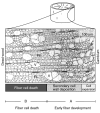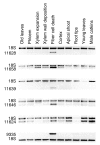A genomic approach to investigate developmental cell death in woody tissues of Populus trees
- PMID: 15833121
- PMCID: PMC1088962
- DOI: 10.1186/gb-2005-6-4-r34
A genomic approach to investigate developmental cell death in woody tissues of Populus trees
Abstract
Background: Poplar (Populus sp.) has emerged as the main model system for molecular and genetic studies of forest trees. A Populus expressed sequence tag (EST) database (POPULUSDB) was previously created from 19 cDNA libraries each originating from different Populus tree tissues, and opened to the public in September 2004. We used this dataset for in silico transcript profiling of a particular process in the woody tissues of the Populus stem: the programmed death of xylem fibers.
Results: One EST library in POPULUSDB originates from woody tissues of the Populus stem where xylem fibers undergo cell death. Analysis of EST abundances and library distribution within the POPULUSDB revealed a large number of previously uncharacterized transcripts that were unique in this library and possibly related to the death of xylem fibers. The in silico analysis was complemented by a microarray analysis utilizing a novel Populus cDNA array with a unigene set of 25,000 sequences.
Conclusions: In silico analysis, combined with the microarray analysis, revealed the usefulness of non-normalized EST libraries in elucidating transcriptional regulation of previously uncharacterized physiological processes. The data suggested the involvement of two novel extracellular serine proteases, nodulin-like proteins and an Arabidopsis thaliana OPEN STOMATA 1 (AtOST1) homolog in signaling fiber-cell death, as well as mechanisms responsible for hormonal control, nutrient remobilization, regulation of vacuolar integrity and autolysis of the dying fibers.
Figures





References
Publication types
MeSH terms
Substances
LinkOut - more resources
Full Text Sources
Molecular Biology Databases
Research Materials

